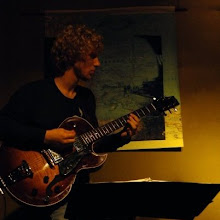
Over a career spanning more than 40 years and nearly 50 albums, John Abercrombie has established himself as one the masters of jazz guitar. Favoring unusual sounds (he played electronic mandolin on McCoy Tyner's 1993 album 4x4) and nontraditional ensembles, Abercrombie is a restless experimenter, working firmly in the jazz tradition while pushing the boundaries of meter and harmony.
Born on December 16, 1944 in Port Chester, New York, Abercrombie grew up in Greenwich, Connecticut, where he began playing the guitar at age 14. Like many teenagers at the time, he started out imitating Chuck Berry licks. But it was the bluesy music of Barney Kessel that attracted him to jazz. Abercrombie enrolled at Boston's Berklee College of Music and teamed up with other students to play local clubs and bars. One of those clubs, Paul's Mall, was connected to a larger club next door, the Jazz Workshop, where Abercrombie ducked in during his free time to watch John Coltrane and Thelonious Monk.
Abercrombie's appearances at Paul's Mall led to several fortuitous meetings. Organist Johnny Hammond Smith spotted the young Abercrombie and invited him to go on tour while he was still a student. During the same period, Abercrombie also met the Brecker Brothers, who invited him to become a new part of their group Dreams, which would become one the prominent jazz-rock bands of the late 1960s and early 1970s. Abercrombie appears on the group's eponymous debut album.
After graduating from Berklee, Abercrombie headed to New York, where he quickly became one of New York's most in-demand session players. He recorded with Gil Evans, Gato Barbieri, and Barry Miles, to name a few, and he was also a regular with Chico Hamilton's group.
It was in Billy Cobham's band, which also featured the Brecker brothers, that Abercrombie first started to build a following though. He was featured on several of Cobham's albums, including Crosswinds, Total Eclipse, and Shabazz, all of which staked new ground in fusion jazz. The group was booked into large concert halls and arenas, appearing on bills with such top rock attractions as the Doobie Brothers. It was not, however, the direction Abercrombie had hoped his career would go. "One night we appeared at the Spectrum in Phildelphia and I thought, what am I doing here?" he said. "It just didn't compute."
In the early 1970s, Abercrombie ran into Manfred Eicher, who invited him to record for ECM. The result was Abercrombie's first solo album, Timeless, in which he was backed by Jan Hammer and Jack DeJohnette. Abercrombie's second album, Gateway, was released in November 1975 with DeJohnette and bassist Dave Holland; a second Gateway recording was released in June 1978.
Abercrombie continued on this path, playing in a variety of settings for ECM over the next 30 years, recording with the likes of Ralph Towner, Peter Erskine, George Mraz, Adam Nussbaum, and Joey Barron, continually pushing the boundaries of jazz and music as a whole.
Here is a clip of Abercrombie playing with the Kenny Wheeler Quintet, also featuring Peter Erskine (drums), John Taylor (piano), and Palle Danielsson (bass).


No comments:
Post a Comment